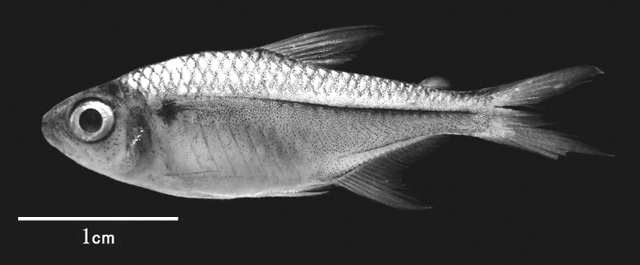| Characidae (Characins; tetras), subfamily: Stethaprioninae |
| 3.05 cm SL (male/unsexed) |
|
pelagic; freshwater |
| South America: Colombia. |
|
Dorsal soft rays (total): 9-9; Anal soft rays: 18-20; Vertebrae: 33-34. This species is distinguished from other members of its species group by the following characters: 5-6 pored lateral-line scales (vs. 7-23), conical maxillary teeth (vs. maxillary teeth tri- or multicuspid); 5 infraorbitals (vs. 6 except in H. heterorhabdus and H. amaronensis with 5); mean body depth 29.65 % SL (vs. 35.71-42.12%; except in H. heterorhabdus with mean body depth 30.39 and H. diancistrus with 23.70); mean upper jaw length 18.94% SL (vs. 22.70-30.51%; except H. amaronensis with 15.66%); presence of a red band above the dark lateral band (vs. without band); males with hooks on all fins (vs. spines not on all fins) (Ref. 84248). |
| Found over organic detritus and decomposing vegetation, apparent water color was brown to black, low dissolved oxygen (0.42-0.75 mg/l), as was conductivity (42-43 μs) and oxygen saturation (5.3-10 %), slightly acidic pH (6.0-6.2). Two of the five stomachs of cleared and stained specimens contain insects (100 %N, 85. 71%V) and unidentified digested material (14.28%V) (Ref. 84248). |
|
Least Concern (LC); Date assessed: 09 October 2014 Ref. (130435)
|
| harmless |
Source and more info: www.fishbase.org. For personal, classroom, and other internal use only. Not for publication.

